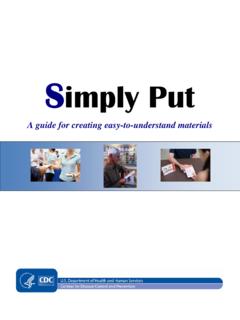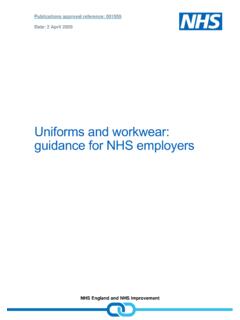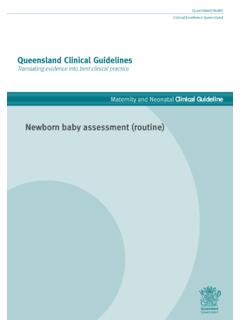Transcription of Information in this document has been archived and has ...
1 archived CONTENT Information in this document has been archived and has since been replaced with more recent guidance. Facility GuidanceFamilies, Friends, and Other VisitorsMandatoryResponsible RestartOhioAssisted Living Facilities Facilities must restrict access only to personnel who are necessary to operations, except as detailed below. Personnel necessary to operations include, but may not be limited to, staff, contracted and emergency healthcare providers, hospice personnel providing core services, clergy, hair salon personnel, contractors conducting critical on-site maintenance, and governmental representatives and regulators and their contractors.
2 All homes must perform COVID-19 testing for residents and staff: Fully vaccinated staff do not have to be routinely tested. A person is fully vaccinated if it has been at least two weeks since receipt of a one-dose vaccine or of the second dose of a two-dose vaccine. All unvaccinated staff must be tested at least twice per week. (Unvaccinated refers to a person who does not fit the definition of fully vaccinated, including people whose vaccination status is not known.) Regardless of vaccination status, strategic testing of all residents and staff must continue.
3 This may include, but is not limited to, testing residents and staff with known or suspected COVID-19 exposure; testing symptomatic staff and residents; or testing staff and residents as determined clinically necessary. Facilities must permit residents to have visitors, so long as all safety standards are met. Facilities should attempt to have as few of points of entry as possible and a designated entry point. (This does not apply to emergency ingress or egress of facilities.) Facilities are required to regularly report visitation Information to the state. Anyone granted access should provide the facility with name and contact Information .
4 Facilities must screen all personnel and visitors each time they enter the facility, including questions about exposure to COVID-19 and assessment for cough, shortness of breath, and body temperature of degrees Fahrenheit or higher. (This does not apply to exigent circumstances, to emergency medical services, first responders, and similarly situated individuals.) Facilities are encouraged to test visitors, if feasible. If so, facilities should prioritize testing visitors who visit regularly ( , weekly), although any visitor can be tested. Facilities may also encourage visitors to be tested on their own prior to coming to the facility ( , within two to three days).
5 When determining when to allow facility and personal visitations, homes should consider: case status in surrounding community; case status in the facility; staffing levels; access to adequate testing for residents and staff; personal protective equipment supplies; local hospital capacity; and implications for resident physical and mental well-being. Providers should educate residents and visitors on the risks of the spread of COVID-19 and the appropriate/applicable safety precautions. Residents must be allowed to discharge at any time and in accordance with applicable state law. Facilities must comply with infection control precautions in Ohio Administrative Code 3701-16-12(C).
6 Facilities must develop visitation policies. Policies shall be made available upon request to residents, visitors, ODH, and any representative of the Office of the State Long-Term Care Ombudsman. Require scheduling of all on-site visits. Provide visitors a time and length for the visit. Visits must be at least 30 minutes in length. Visits do not commence until residents and visitors are together. Screen visitors for COVID-19 symptoms, including symptoms assessment and questions about exposure to COVID-19. Maintain a log of visitors that includes name and contact Information and retain Information in accordance with federal and state requirements.
7 Logs must be made available upon request to residents, visitors, the Department of Health, and any representative of the Office of the State Long-Term Care Ombudsman. During visits, require visitors to wear a mask and require residents, where possible, to also wear a mask. Masks should never be placed on children younger than the age of 2. Require that all visitors be able to facilitate social distancing and wear a mask and not be a distraction to other residents, visitors, or staff. No more than two visitors shall be permitted per resident per visit. If more than one resident has a visitor, or a resident has multiple visitors, provide enough space to permit all visitors and residents to maintain appropriate distance from each other.
8 Encourage residents and visitors to have a contact-free State Long-Term Care Ombudsman, an office within the Ohio Department of Aging, is a good resource for families and others with loved ones in assisted living facilities during this time. The Ombudsman can be reached at 1-800-282-1206. Revised 5/5/2021 MandatoryCommunal Activities and Other ServicesCompassionate Care Facilities must adhere to all relevant Centers for Disease control and Prevention (CDC) guidance for dining and communal activities. Facilities must allow compassionate care visits at all times, regardless of a resident s vaccination status, the county s COVID-19 positivity rate, or an outbreak.
9 Compassionate care situations do not exclusively refer to end-of-life situations. Examples of other types of compassionate care situations include, but are not limited to: A resident, who was living with their family before recently being admitted to a nursing home, is struggling with the change in environment and lack of physical family support. A resident is grieving after a friend or family member recently died. A resident who needs cueing and encouragement with eating or drinking, previously provided by family and/or caregiver(s), is experiencing weight loss or dehydration.
10 A resident who used to talk and interact with others is experiencing emotional distress, seldom speaking, or crying more frequently. A resident has been readmitted to the facility following an acute care admission to the hospital. A resident has a new order for an anti-psychotic, an anti-depressant, or an appetite stimulant. A resident s dementia has dramatically progressed. A resident is no longer responding to loved ones during virtual visits. Family members mention that they notice a change in the resident s appearance, grooming, or cognition during window or virtual visits.





